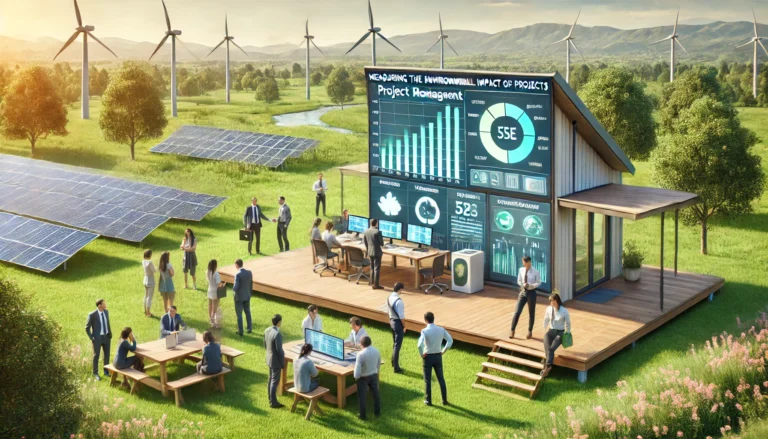Introduction
In an era where environmental consciousness is paramount, project managers are increasingly tasked with not only delivering successful projects but also ensuring they do so in an environmentally responsible manner. The measurement and management of a project’s environmental impact have become crucial aspects of sustainable project management, reflecting a global shift towards more eco-friendly practices across industries. This article delves into the importance of environmental impact assessment, explores key metrics to consider, and outlines strategies for implementing sustainable practices in project management.
The Importance of Measuring Environmental Impact
Understanding and measuring the environmental impact of projects is essential for several interconnected reasons:
- Regulatory Compliance: Many regions now have strict environmental regulations that projects must adhere to. For example, the European Union’s Environmental Impact Assessment Directive requires certain projects to undergo formal environmental assessments.
- Stakeholder Expectations: Clients, investors, and the public increasingly expect projects to be environmentally responsible. A 2021 PwC survey found that 76% of consumers would discontinue their relationships with companies that treat the environment poorly.
- Risk Management: Identifying and mitigating environmental risks can prevent costly issues and delays. For instance, a construction project that fails to consider its impact on local water sources might face significant delays and fines.
- Cost Efficiency: Sustainable practices often lead to reduced resource consumption and long-term cost savings. The World Green Building Council reports that green buildings with improved energy efficiency can reduce operating costs by up to 37%.
- Corporate Social Responsibility: Demonstrating environmental stewardship enhances an organisation’s reputation and can lead to improved stakeholder relationships and business opportunities.
Key Metrics for Measuring Environmental Impact
To effectively assess the environmental impact of a project, consider the following key metrics:
1. Carbon Footprint
Measure the total greenhouse gas emissions produced directly and indirectly by the project. This includes:
- Direct Emissions: From project activities, such as fuel consumption by equipment.
- Indirect Emissions: From purchased electricity, supplier activities, and employee travel.
Example: A software development project might measure emissions from data centers, office energy use, and employee commuting.
2. Energy Consumption
Track the total energy used throughout the project lifecycle, including:
- Electricity usage
- Fuel consumption
- Renewable vs. non-renewable energy sources
Consider implementing energy monitoring systems to track consumption in real-time and identify areas for improvement.
3. Water Usage
Monitor the amount of water consumed and any impacts on local water sources:
- Water consumption in project processes
- Effects on local water quality
- Water recycling and conservation efforts
For instance, a manufacturing project might track water used in production processes, implement water recycling systems, and monitor any discharge into local water bodies.
4. Waste Generation and Management
Assess the amount and types of waste produced:
- Quantity of waste generated
- Proportion of waste recycled or reused
- Hazardous waste management
Implement a waste management hierarchy: Reduce, Reuse, Recycle, and Dispose. For example, a construction project could track the percentage of materials recycled or reused on-site.
5. Land Use and Biodiversity Impact
Evaluate how the project affects local ecosystems:
- Area of land disturbed or transformed
- Impact on local flora and fauna
- Efforts to preserve or restore natural habitats
This is particularly important for projects in sensitive ecological areas. For example, an infrastructure project might conduct biodiversity surveys before, during, and after the project to assess its impact.
6. Air Quality
Measure emissions that affect local air quality:
- Particulate matter emissions
- Volatile organic compound (VOC) emissions
- Efforts to reduce air pollution
Consider using air quality monitoring equipment to track these metrics throughout the project lifecycle.
7. Material Consumption
Assess the use of raw materials and the potential for using recycled or sustainable alternatives:
- Quantity and type of materials used
- Proportion of recycled or sustainably sourced materials
- Efforts to reduce material consumption
For example, a product design project might track the percentage of recycled materials used and implement strategies to minimize packaging.
Tools and Techniques for Environmental Impact Assessment
Several tools and techniques can aid in measuring and analysing environmental impact:
1. Life Cycle Assessment (LCA)
LCA evaluates the environmental impacts of a project throughout its entire lifecycle, from raw material extraction to end-of-life disposal. This comprehensive approach helps identify areas where the most significant improvements can be made.
2. Environmental Impact Assessment (EIA)
A formal process to predict the environmental consequences of a proposed project and plan for mitigation. EIAs typically involve:
- Scoping to determine the assessment’s extent
- Baseline studies of the current environment
- Impact prediction and evaluation
- Mitigation planning
- Public consultation and review
3. Carbon Calculators
Specialised tools for estimating the carbon footprint of project activities. These range from simple online calculators to sophisticated software that can handle complex project data.
4. Environmental Management Systems (EMS)
Frameworks like ISO 14001 that help organisations manage their environmental responsibilities. An EMS typically includes:
- Environmental policy development
- Planning and implementation
- Monitoring and corrective action
- Management review and continuous improvement
5. Sustainability Reporting Tools
Software platforms that aid in collecting, analysing, and reporting environmental data. These tools often offer features like automated data collection, real-time dashboards, and report generation capabilities.
6. Green Building Rating Systems
For construction projects, systems like LEED or BREEAM provide comprehensive frameworks for assessing environmental performance. These systems cover aspects such as:
- Energy efficiency
- Water conservation
- Material use and waste reduction
- Indoor environmental quality
- Site selection and management
Strategies for Implementing Sustainable Practices
Measuring environmental impact is just the first step. Here are strategies for implementing sustainable practices in project management:
- Set Clear Environmental Objectives: Establish specific, measurable environmental goals for each project at the outset. For example, “Reduce energy consumption by 20% compared to the previous project.”
- Integrate Sustainability into Project Planning: Incorporate environmental considerations into all stages of project planning and decision-making. This might involve including sustainability criteria in project selection processes or conducting environmental reviews at key project milestones.
- Engage Stakeholders: Involve stakeholders in environmental goal-setting and seek their input on sustainability initiatives. This could include conducting stakeholder workshops or establishing a sustainability advisory board for large projects.
- Prioritise Sustainable Procurement: Choose suppliers and materials based on their environmental credentials. Develop a sustainable procurement policy and consider using tools like the Environmental Product Declaration (EPD) to compare the environmental impact of different products.
- Implement Energy Efficiency Measures: Look for opportunities to reduce energy consumption throughout the project lifecycle. This might involve using energy-efficient equipment, optimizing processes, or implementing smart energy management systems.
- Minimise Waste: Develop and implement a comprehensive waste reduction and management plan. Consider adopting circular economy principles where possible, finding ways to reuse or recycle materials within the project or in other projects.
- Encourage Sustainable Transport: Promote the use of low-emission vehicles and public transport for project-related travel. For long-term projects, consider installing electric vehicle charging points or providing incentives for sustainable commuting.
- Provide Training and Awareness: Educate project team members about environmental impacts and sustainable practices. This could involve regular training sessions, sustainability challenges, or creating a network of sustainability champions within the project team.
- Monitor and Report Regularly: Continuously track environmental metrics and report progress to stakeholders. Consider using visual dashboards to make environmental performance data easily accessible and understandable.
- Continuous Improvement: Use lessons learned to improve environmental performance in future projects. Conduct post-project reviews that include environmental performance and feed these insights into the planning of future projects.
Challenges in Measuring Environmental Impact
While crucial, measuring environmental impact comes with its challenges:
- Data Collection: Gathering accurate and comprehensive environmental data can be complex and time-consuming, especially for large or geographically dispersed projects.
- Standardisation: Lack of universal standards for environmental impact measurement can make comparisons difficult. Different methodologies may yield varying results, making it challenging to benchmark performance.
- Scope Definition: Determining the boundaries of what to include in the assessment can be challenging. Should indirect impacts be included? How far up or down the supply chain should the assessment go?
- Long-term Impacts: Some environmental impacts may only become apparent long after project completion, making it difficult to fully assess a project’s environmental footprint during its active phase.
- Balancing Priorities: Reconciling environmental goals with other project objectives like time and cost can be challenging. There may be situations where environmental best practices conflict with traditional project management priorities.
Conclusion
Measuring the environmental impact of projects is no longer optional; it’s a crucial aspect of responsible project management. By understanding key metrics, utilising appropriate tools, and implementing sustainable strategies, project managers can significantly reduce the environmental footprint of their projects while often improving efficiency and stakeholder satisfaction.
As we move towards a more sustainable future, the ability to effectively measure and manage environmental impact will become an increasingly valuable skill for project managers. It’s not just about compliance or risk management; it’s about contributing to a more sustainable world through responsible project practices.
At Venko, we recognise the growing importance of sustainable project management. Our team is equipped with the latest tools and knowledge to help you measure and mitigate the environmental impact of your projects. Whether you’re looking to implement comprehensive environmental impact assessments, develop sustainable project strategies, or train your team in eco-friendly project practices, Venko can provide the expertise and support you need. Contact us today to learn how we can help you integrate sustainability into your project management practices, ensuring your projects are not only successful but also environmentally responsible.


